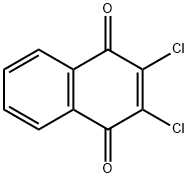
2,3-дихлор-1 ,4-нафтохинона
- английское имя2,3-Dichloro-1,4-naphthoquinone
- CAS №117-80-6
- CBNumberCB3469109
- ФормулаC10H4Cl2O2
- мольный вес227.04
- EINECS204-210-5
- номер MDLMFCD00001677
- файл Mol117-80-6.mol
| Температура плавления | 194-197 °C (lit.) |
| Температура кипения | 275 °C (2 mmHg) |
| плотность | 1.4057 (rough estimate) |
| давление пара | 0Pa at 20℃ |
| показатель преломления | 1.5410 (estimate) |
| Fp | 275°C/2mm |
| температура хранения | Store below +30°C. |
| форма | Fine Crystalline Powder |
| цвет | Yellow |
| Растворимость в воде | 0.008 g/L |
| Мерк | 14,3045 |
| БРН | 1073511 |
| LogP | 2.9 at 23℃ |
| Справочник по базе данных CAS | 117-80-6(CAS DataBase Reference) |
| Рейтинг продуктов питания EWG | 1-2 |
| FDA UNII | C28BKZ2J9A |
| Справочник по химии NIST | 1,4-Naphthalenedione, 2,3-dichloro-(117-80-6) |
| Система регистрации веществ EPA | Dichlone (117-80-6) |
| UNSPSC Code | 41116107 |
| NACRES | NA.24 |
| Коды опасности | Xn,N | |||||||||
| Заявления о рисках | 22-36/38-50/53 | |||||||||
| Заявления о безопасности | 26-60-61 | |||||||||
| РИДАДР | UN 2811 6.1/PG 3 | |||||||||
| WGK Германия | 3 | |||||||||
| RTECS | QL7525000 | |||||||||
| TSCA | Yes | |||||||||
| Класс опасности | 6.1 | |||||||||
| Группа упаковки | III | |||||||||
| кода HS | 29147090 | |||||||||
| Банк данных об опасных веществах | 117-80-6(Hazardous Substances Data) | |||||||||
| Токсичность | LD50 orally in rats: 1300 mg/kg (Bailey, White) | |||||||||
| NFPA 704: |
|
рисовальное письмо(GHS)
-
рисовальное письмо(GHS)


-
сигнальный язык
опасность
-
вредная бумага
H315:При попадании на кожу вызывает раздражение.
H319:При попадании в глаза вызывает выраженное раздражение.
H301:Токсично при проглатывании.
H410:Чрезвычайно токсично для водных организмов с долгосрочными последствиями.
-
оператор предупредительных мер
P264:После работы тщательно вымыть кожу.
P270:При использовании продукции не курить, не пить, не принимать пищу.
P273:Избегать попадания в окружающую среду.
P301+P310:ПРИ ПРОГЛАТЫВАНИИ: Немедленно обратиться за медицинской помощью. Прополоскать рот.
P302+P352:ПРИ ПОПАДАНИИ НА КОЖУ: Промыть большим количеством воды.
P305+P351+P338:ПРИ ПОПАДАНИИ В ГЛАЗА: Осторожно промыть глаза водой в течение нескольких минут. Снять контактные линзы, если Вы ими пользуетесь и если это легко сделать. Продолжить промывание глаз.
2,3-дихлор-1 ,4-нафтохинона химические свойства, назначение, производство
Химические свойства
YELLOW FINE CRYSTALLINE POWDERИспользование
Fungicide for agriculture and textiles; herbicide.Общее описание
2,3-Dichloro-1,4-naphthoquinone is a yellow crystalline solid dissolved in a water-emulsifiable liquid carrier. Can cause illness by inhalation, skin absorption and/or ingestion. The primary hazard is the threat to the environment. Immediate steps should be taken to limit its spread to the environment. Can easily penetrate the soil and contaminate groundwater and nearby streams. Used as a fungicide.Реакции воздуха и воды
Insoluble in water.Профиль реактивности
2,3-Dichloro-1,4-naphthoquinone is a halogenated ketone. Ketones are reactive with many acids and bases liberating heat and flammable gases (e.g., H2). The amount of heat may be sufficient to start a fire in the unreacted portion of the ketone. Ketones react with reducing agents such as hydrides, alkali metals, and nitrides to produce flammable gas (H2) and heat. Ketones are incompatible with isocyanates, aldehydes, cyanides, peroxides, and anhydrides. They react violently with aldehydes, HNO3, HNO3 + H2O2, and HClO4.Угроза здоровью
INHALATION: Irritation to mucous membrane. EYES: Irritation. SKIN: Irritation. INGESTION: Can cause CNS depression.Пожароопасность
Special Hazards of Combustion Products: Highly toxic fumes are imminent.Сельскохозяйственное использование
Fungicide: Not currently registered in the U.S. Not approved for use in the EU. Dichlone is used as a fungicide for foliage and to control blue algae in ponds, swimming pools and lakes. As a substitute for copper and sulfur to control rot on fruit trees, vegetables, field crops, ornamentals, resident and commercial outdoor areas.Торговое название
ALGISTAT®; COMPOUND 604®; PHYGON®; PHYGON® PASTE; PHYGON® SEED PROTECTANT; PHYGON® XL; QUINTAR®; QUINTAR® 540F; SANQUINON®; UNIROYAL® 604; USR® 604; U.S. RUBBER® 604Профиль безопасности
Poison by ingestion and intraperitoneal routes. Mildly toxic by skin contact. A skin, eye, and mucous membrane irritant. Large doses can cause central nervous system depression. Questionable carcinogen with experimental carcinogenic and neoplastigenic data. A fungcide and algicide. When heated to decomposition it emits toxic fumes of Cl-. See also CHLORIDES.Экологическая судьба
Plant. In plants, dichlone loses both chlorine atoms and are replaced by sulphydryl groups to give a substituted dimercapto compound (Hartley and Kidd, 1987).Photolytic. The UV absorption band for dichlone is 330 nm (Gore et al., 1971). Irradiation of dichlone in a variety of organic solvents (benzene, isopropanol, ethanol) using UV light produced a number of dehalogenated compounds. In the absence or presence of oxygen, 2-chloro-1,4-naphthoquinone, 1,4-naphthoquinone and 1,4-naphthalenediol were produced. Further irradiation in the presence of oxygen yielded phthalic acid and phthalic anhydride as the major products. In a mixture of benzene and isopropanol, dichlone degraded to the minor products: 2-chloro-3-hydroxy-1,4-naphthoquinone, 2- chloro-3-phenoxy-1,4-naphthoquinone, 2,3-dichloro-4-hydroxy-1-keto-2-phenyl-1,2- dihydronaphthalene and isopropyl-1-chloro-2,3-dioxo-1-indanecarboxylate (Ide et al., 1979).
Chemical/Physical. Emits toxic fumes of chlorine when heated to decomposition (Sax and Lewis, 1987).
Методы очистки
Crystallise the quinone from EtOH. [Beilstein 7 IV 2426.]2,3-дихлор-1 ,4-нафтохинона запасные части и сырье
2,3-дихлор-1 ,4-нафтохинона поставщик
| поставщик | телефон | страна | номенклатура продукции | благоприятные условия |
|---|---|---|---|---|
| +86-13131129325 | China | 5887 | 58 | |
| +86-0371-55170693 +86-19937530512 |
China | 21632 | 55 | |
| +86-0371-86658258 +8613203830695 |
China | 29871 | 58 | |
| +86 18953170293 | China | 2930 | 58 | |
| 18871490254 | CHINA | 28172 | 58 | |
| +86-86-5926051114 +8618959220845 |
China | 6383 | 58 | |
| 86-13657291602 | CHINA | 22963 | 58 | |
| +86-023-6139-8061 +86-86-13650506873 |
China | 39894 | 58 | |
| 8485655694 | United States | 63687 | 58 | |
| +8618523575427 | China | 49732 | 58 |